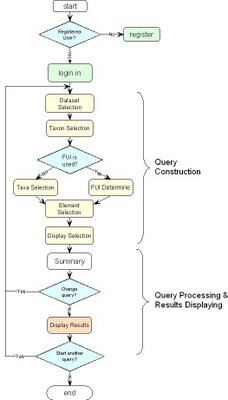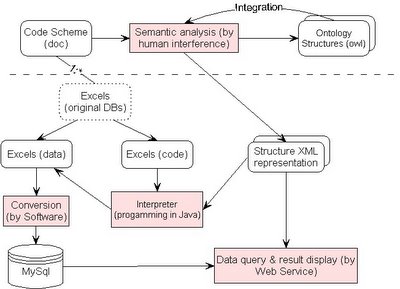The report gives a simple description of overview of the implementation of interface for KADIS.
In the very phase, my work is to do with an implementation of the simple interface for the project Kadis. The interface will show a light on the basic interactive operations between web browser and users who are potentially interested with this project. On the other hand, my work is a natural extension from those of Toufeeq. So it's necessary to describe his work at the first place. According to him, he worked on the integration of ontology from different data base, honestly just two. The figure below presents the overview of the work that has been done for the project. The part above the dash line is done by Toufeeq, and the part below is mine.
Toufeeq's work:
1. For each different dataset, there is a corresponding 'code' scheme recording the code-value pair for each term used in the dataset. It's a system to simplify notes in the file. Toufeeq used Protege (an open-source software special in the management of ontology information. ) to construct and manage the ontology structure of each dataset based on its code scheme. The corresponding owl file is generated for each code scheme.
Some improvements are required:
1) The terms in the code file (.doc) are not completely consistent with those in the owl file.
2) The owl file is hard to understand. It's not a good idea to generate the ontology file automatically by Protege.
3) I am thinking whether it's a good way to organize the ontological information with the software Protege. It's glad to know it's open source project, but that's not mean it's the best choice in our own project. On the other hand, I am curious of the ability to control and exploit such a software efficiently before taking a lot time on understanding and learning to use.
2. The integration of different ontology are done by means of Protege, but human interference is necessary. I believe the role of human interference in the procedure is much more important than that of Protege. Protege is at all a tool, it's able to assist to represent and communicate, but not come up with solutions. So the main problem is still to do with people.
Some improvements are required on the basis of the current work.
1) A document is required to describe the work that has been finished in detail.
2) Please pay more attention to the algorithm to resolve the conflicts in the different ontological system, not to the tools or something else.
3) By the way, Toufeeq programmed a little to assist the generation of integrating dataset according to the integrated ontology scheme (owl file). I hate to do an evaluation of other's code, but I have to say, these code are not useful in the following work unfortunately.
(Toufeeq has said good-bye to this project, I guess, pleased. But I can not for the moment, faced with such an awful mess. There is a lot of work to do. I hope I'd better not spend too much time on that because I have other stuff to do. )
My work: query and display the results through web services
1) Based on the owl files provided by Toufeeq, I combined the ontology structure and code scheme with an XML scheme.
2) Base on the Xml Scheme and the original excel files, I convert the codes in the excel file into their corresponding values. And the new excel files are produced storing the values of each items instead of the code/numbers. This process is implemented by programming in Java.
3) With a software, all excel datasets are converted in the form of MySql.
4) The rest is to construct an interface to implement the query and display results by means of Web Services. The basic architecture is client-server, and the languages used here include php, javascript. If possible more details are going to be provided in the following days.

